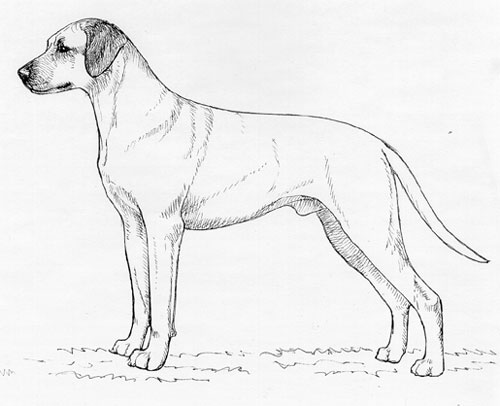Rhodesian Ridgeback
Sighthound and Pariah Dog Group
The goals and purposes of this breed standard include: to furnish guidelines for breeders who wish to maintain the quality of their breed and to improve it; to advance this breed to a state of similarity throughout the world; and to act as a guide for judges.
Breeders and judges have the responsibility to avoid any conditions or exaggerations that are detrimental to the health, welfare, essence and soundness of this breed, and must take the responsibility to see that these are not perpetuated.
Any departure from the following should be considered a fault, and the seriousness with which the fault should be regarded should be in exact proportion to its degree and its effect upon the health and welfare of the dog and on the dog’s ability to perform its traditional work.
History
The Rhodesian Ridgeback is indigenous to Southern Africa. Its ancestors trace to the Cape Colony, where they were crossed with the early pioneer’s dogs and the semi-domesticated, ridged Hottentot’s hunting dogs. The original function of the breed was to hunt in packs of two or three, tracking game, especially lion, and keeping it at bay until the hunters arrived. Today, while the Rhodesian Ridgeback is still used to hunt game in many parts of the world, it is especially prized as a watch dog and companion.
The Rhodesian Ridgeback was recognized by the United Kennel Club in 1980.
General Appearance
The Rhodesian Ridgeback is a symmetrical, well balanced, strong, muscular dog, yet it must be active and agile, and capable of great endurance with a fair amount of speed. The emphasis is on agility, elegance and soundness, with no tendency towards massiveness.
The distinctive characteristic peculiar to the breed is a ridge on the back that is formed by the hair growing in an opposite direction from the rest of the coat. The ridge is clearly defined, tapering and symmetrical. It begins immediately behind the shoulders and continues to a point located between the prominences of the hips. It should contain two identical crowns opposite each other, the lower edges of which do not extend farther down the ridge than one-third of the length of the ridge. A good average width of the ridge is two inches.
Working dogs are not to be penalized under any conditions for scars or blemishes that are due to hunting injuries.
Disqualifications: Lack of a ridge. Unilateral or bilateral cryptorchid.
Characteristics
Intelligent and dignified, the Rhodesian Ridgeback can be aloof with strangers, but is never shy or aggressive.
Disqualifications: Viciousness or extreme shyness.
Head
SKULL
The skull is of fair length. The width of the skull between the ears, the length of the skull, and the length of the muzzle should all be equal. The skull is flat between the ears, and free of wrinkles when the dog is in repose. The stop is reasonably well defined; not in one straight line from the nose to the occiput.
MUZZLE
The muzzle is long, deep and powerful, with close fitting lips. The cheeks are clean.
Faults: Heavy head; round skull; short, snipey muzzle; bulging cheeks.
TEETH
A full complement of strong, well-developed, white teeth meet in a scissors bite. The canine teeth are especially well developed.
EYES
The round eyes are set moderately well apart. They are bright, sparkling and have an intelligent expression. Eye color is in harmony with that of the color of the dog. A black nosed dog has dark eyes; a brown-nosed dog has amber eyes.
NOSE
The nose has black or brown pigment, in harmony with the color of the dog. No other colored noses are acceptable.
EARS
The medium-sized ears are set rather high and carried close to the head. They are rather wide at the base and taper to a rounded point.
Neck
The neck is fairly long, strong and free from throatiness.
Forequarters
The sloping shoulders are clean and muscular.
FORELEGS
The heavily boned, strong forelegs are perfectly straight. The elbows are close to the body. The pasterns have a slight spring.
Body
The chest is very deep and capacious, but not too wide. The brisket reaches to the elbow. There is a visible forechest when the dog is viewed from the side. The back is powerful, and the ribs are moderately well sprung, never barrel shaped. The loin is strong, muscular and slightly arched.
Hindquarters
HIND LEGS
The muscles in the hind legs are clean and well defined. There is a good turn of stifle, and the hocks are strong and well let down.
Feet
The round, compact feet have well-arched toes and tough, elastic pads. The feet are protected by hair between the toes and the pads.
Tail
The tail is strong at the root and tapers gradually toward the tip. It is free from coarseness. It is carried with a slight upward curve.
Faults: Curled tail; set too high or too low.
Coat
The short, dense coat is sleek and glossy. It is never woolly or silky.
Color
Acceptable colors include the range from light wheaten to red wheaten. Dark muzzles and ears are acceptable. Excessive black hairs throughout the coat are highly undesirable. A small amount of white on the chest and on the toes is acceptable, but any other white is undesirable.
Disqualification: Albinism.
Height & Weight
The height ranges for mature dogs are: males, 25 to 27 inches; females, 24 to 26 inches.
The approximate weights for mature dogs are: males, 80 pounds; females, 70 pounds.
Gait
Movement is straightforward, free and active.
Disqualifications
(A dog with a Disqualification must not be considered for placement in a conformation event, and must be reported to UKC.)
Unilateral or bilateral cryptorchid.
Viciousness or extreme shyness.
Albinism.
Lack of a ridge.

Looking for a Dog?
Find a dog that will fit your family.
Note: The breeders on this list are not endorsed by UKC.
Revised December 1, 2014
©Copyright 1992, United Kennel Club
